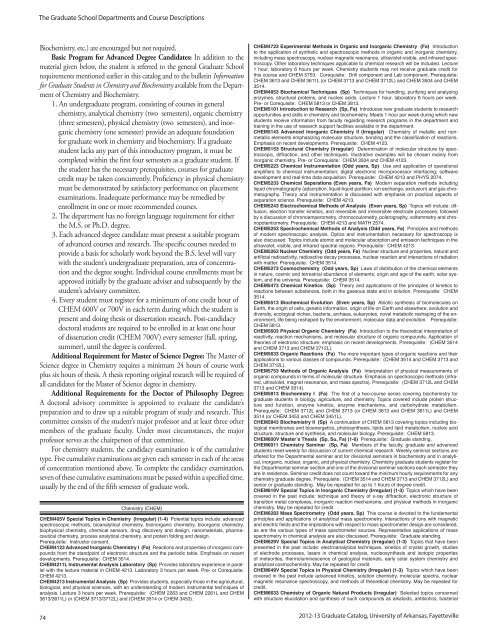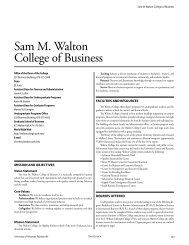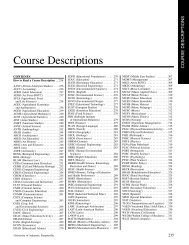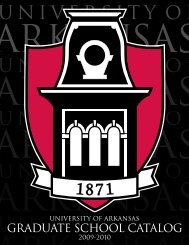PDF of the Graduate Catalog of Studies (2.6 MB)
PDF of the Graduate Catalog of Studies (2.6 MB)
PDF of the Graduate Catalog of Studies (2.6 MB)
You also want an ePaper? Increase the reach of your titles
YUMPU automatically turns print PDFs into web optimized ePapers that Google loves.
The <strong>Graduate</strong> School Departments and Course Descriptions<br />
Biochemistry, etc.) are encouraged but not required.<br />
Basic Program for Advanced Degree Candidates: In addition to <strong>the</strong><br />
material given below, <strong>the</strong> student is referred to <strong>the</strong> general <strong>Graduate</strong> School<br />
requirements mentioned earlier in this catalog and to <strong>the</strong> bulletin Information<br />
for <strong>Graduate</strong> Students in Chemistry and Biochemistry available from <strong>the</strong> Department<br />
<strong>of</strong> Chemistry and Biochemistry.<br />
1. An undergraduate program, consisting <strong>of</strong> courses in general<br />
chemistry, analytical chemistry (two semesters), organic chemistry<br />
(three semesters), physical chemistry (two semesters), and inorganic<br />
chemistry (one semester) provide an adequate foundation<br />
for graduate work in chemistry and biochemistry. If a graduate<br />
student lacks any part <strong>of</strong> this introductory program, it must be<br />
completed within <strong>the</strong> first four semesters as a graduate student. If<br />
<strong>the</strong> student has <strong>the</strong> necessary prerequisites, courses for graduate<br />
credit may be taken concurrently. Pr<strong>of</strong>iciency in physical chemistry<br />
must be demonstrated by satisfactory performance on placement<br />
examinations. Inadequate performance may be remedied by<br />
enrollment in one or more recommended courses.<br />
2. The department has no foreign language requirement for ei<strong>the</strong>r<br />
<strong>the</strong> M.S. or Ph.D. degree.<br />
3. Each advanced degree candidate must present a suitable program<br />
<strong>of</strong> advanced courses and research. The specific courses needed to<br />
provide a basis for scholarly work beyond <strong>the</strong> B.S. level will vary<br />
with <strong>the</strong> student’s undergraduate preparation, area <strong>of</strong> concentration<br />
and <strong>the</strong> degree sought. Individual course enrollments must be<br />
approved initially by <strong>the</strong> graduate adviser and subsequently by <strong>the</strong><br />
student’s advisory committee.<br />
4. Every student must register for a minimum <strong>of</strong> one credit hour <strong>of</strong><br />
CHEM 600V or 700V in each term during which <strong>the</strong> student is<br />
present and doing <strong>the</strong>sis or dissertation research. Post-candidacy<br />
doctoral students are required to be enrolled in at least one hour<br />
<strong>of</strong> dissertation credit (CHEM 700V) every semester (fall, spring,<br />
summer), until <strong>the</strong> degree is conferred.<br />
Additional Requirement for Master <strong>of</strong> Science Degree: The Master <strong>of</strong><br />
Science degree in Chemistry requires a minimum 24 hours <strong>of</strong> course work<br />
plus six hours <strong>of</strong> <strong>the</strong>sis. A <strong>the</strong>sis reporting original research will be required <strong>of</strong><br />
all candidates for <strong>the</strong> Master <strong>of</strong> Science degree in chemistry.<br />
Additional Requirements for <strong>the</strong> Doctor <strong>of</strong> Philosophy Degree:<br />
A doctoral advisory committee is appointed to evaluate <strong>the</strong> candidate’s<br />
preparation and to draw up a suitable program <strong>of</strong> study and research. This<br />
committee consists <strong>of</strong> <strong>the</strong> student’s major pr<strong>of</strong>essor and at least three o<strong>the</strong>r<br />
members <strong>of</strong> <strong>the</strong> graduate faculty. Under most circumstances, <strong>the</strong> major<br />
pr<strong>of</strong>essor serves as <strong>the</strong> chairperson <strong>of</strong> that committee.<br />
For chemistry students, <strong>the</strong> candidacy examination is <strong>of</strong> <strong>the</strong> cumulative<br />
type. Five cumulative examinations are given each semester in each <strong>of</strong> <strong>the</strong> areas<br />
<strong>of</strong> concentration mentioned above. To complete <strong>the</strong> candidacy examination,<br />
seven <strong>of</strong> <strong>the</strong>se cumulative examinations must be passed within a specified time,<br />
usually by <strong>the</strong> end <strong>of</strong> <strong>the</strong> fifth semester <strong>of</strong> graduate work.<br />
74<br />
Chemistry (CHEM)<br />
CHEM405V Special Topics in Chemistry (Irregular) (1-4) Potential topics include: advanced<br />
spectroscopic methods, bioanalytical chemistry, bioinorganic chemistry, bioorganic chemistry,<br />
biophysical chemistry, chemical sensors, drug discovery and design, nanomaterials, pharmaceutical<br />
chemistry, process analytical chemistry, and protein folding and design.<br />
Prerequisite: Instructor consent.<br />
CHEM4123 Advanced Inorganic Chemistry I (Fa) Reactions and properties <strong>of</strong> inorganic compounds<br />
from <strong>the</strong> standpoint <strong>of</strong> electronic structure and <strong>the</strong> periodic table. Emphasis on recent<br />
developments. Prerequisite: CHEM 3514.<br />
CHEM4211L Instrumental Analysis Laboratory (Sp) Provides laboratory experience in parallel<br />
with <strong>the</strong> lecture material in CHEM 4213. Laboratory 3 hours per week. Pre- or Corequisite:<br />
CHEM 4213.<br />
CHEM4213 Instrumental Analysis (Sp) Provides students, especially those in <strong>the</strong> agricultural,<br />
biological, and physical sciences, with an understanding <strong>of</strong> modern instrumental techniques <strong>of</strong><br />
analysis. Lecture 3 hours per week. Prerequisite: (CHEM 2263 and CHEM 2261L and CHEM<br />
3613/3611L) or (CHEM 3713/3712L) and (CHEM 3514 or CHEM 3453).<br />
CHEM4723 Experimental Methods in Organic and Inorganic Chemistry (Fa) Introduction<br />
to <strong>the</strong> application <strong>of</strong> syn<strong>the</strong>tic and spectroscopic methods in organic and inorganic chemistry,<br />
including mass spectroscopy, nuclear magnetic resonance, ultraviolet-visible, and infrared spectroscopy.<br />
O<strong>the</strong>r laboratory techniques applicable to chemical research will be included. Lecture<br />
1 hour, laboratory 6 hours per week. Chemistry students may not receive graduate credit for<br />
this course and CHEM 5753. Corequisite: Drill component and Lab component. Prerequisite:<br />
CHEM 3613 and CHEM 3611L (or CHEM 3713 and CHEM 3712L) and CHEM 3504 and CHEM<br />
3514.<br />
CHEM4853 Biochemical Techniques (Sp) Techniques for handling, purifying and analyzing<br />
enzymes, structural proteins, and nucleic acids. Lecture 1 hour, laboratory 6 hours per week.<br />
Pre- or Corequisite: CHEM 5813 or CHEM 3813.<br />
CHEM5101 Introduction to Research (Sp, Fa) Introduces new graduate students to research<br />
opportunities and skills in chemistry and biochemistry. Meets 1 hour per week during which new<br />
students receive information from faculty regarding research programs in <strong>the</strong> department and<br />
training in <strong>the</strong> use <strong>of</strong> research support facilities available in <strong>the</strong> department.<br />
CHEM5143 Advanced Inorganic Chemistry II (Irregular) Chemistry <strong>of</strong> metallic and nonmetallic<br />
elements emphasizing molecular structure, bonding and <strong>the</strong> classification <strong>of</strong> reactions.<br />
Emphasis on recent developments. Prerequisite: CHEM 4123.<br />
CHEM5153 Structural Chemistry (Irregular) Determination <strong>of</strong> molecular structure by spectroscopic,<br />
diffraction, and o<strong>the</strong>r techniques. Illustrative examples will be chosen mainly from<br />
inorganic chemistry. Pre- or Corequisite: CHEM 3504 and CHEM 4123.<br />
CHEM5223 Chemical Instrumentation (Odd years, Sp) Use and application <strong>of</strong> operational<br />
amplifiers to chemical instrumentation; digital electronic microprocessor interfacing; s<strong>of</strong>tware<br />
development and real-time data acquisition. Prerequisite: CHEM 4213 and PHYS 2074.<br />
CHEM5233 Chemical Separations (Even years, Fa) Modern separation methods including<br />
liquid chromatography (adsorption, liquid-liquid partition, ion exchange, exclusion) and gas chromatography.<br />
Theory and instrumentation is discussed with emphasis on practical aspects <strong>of</strong><br />
separation science. Prerequisite: CHEM 4213.<br />
CHEM5243 Electrochemical Methods <strong>of</strong> Analysis (Even years, Sp) Topics will include: diffusion,<br />
electron transfer kinetics, and reversible and irreversible electrode processes; followed<br />
by a discussion <strong>of</strong> chronoamperometry, chronocoulometry, polarography, voltammetry and chronopotentiometry.<br />
Prerequisite: CHEM 4213 and MATH 2574.<br />
CHEM5253 Spectrochemical Methods <strong>of</strong> Analysis (Odd years, Fa) Principles and methods<br />
<strong>of</strong> modern spectroscopic analysis. Optics and instrumentation necessary for spectroscopy is<br />
also discussed. Topics include atomic and molecular absorption and emission techniques in <strong>the</strong><br />
ultraviolet, visible, and infrared spectral regions. Prerequisite: CHEM 4213.<br />
CHEM5263 Nuclear Chemistry (Odd years, Fa) Nuclear structure and properties, natural and<br />
artificial radioactivity, radioactive decay processes, nuclear reaction and interactions <strong>of</strong> radiation<br />
with matter. Prerequisite: CHEM 3514.<br />
CHEM5273 Cosmochemistry (Odd years, Sp) Laws <strong>of</strong> distribution <strong>of</strong> <strong>the</strong> chemical elements<br />
in nature, cosmic and terrestrial abundance <strong>of</strong> elements; origin and age <strong>of</strong> <strong>the</strong> earth, solar system,<br />
and <strong>the</strong> universe. Prerequisite: CHEM 3514.<br />
CHEM5473 Chemical Kinetics (Sp) Theory and applications <strong>of</strong> <strong>the</strong> principles <strong>of</strong> kinetics to<br />
reactions between substances, both in <strong>the</strong> gaseous state and in solution. Prerequisite: CHEM<br />
3514.<br />
CHEM5513 Biochemical Evolution (Even years, Sp) Abiotic syn<strong>the</strong>sis <strong>of</strong> biomolecules on<br />
Earth, <strong>the</strong> origin <strong>of</strong> cells, genetic information, origin <strong>of</strong> life on Earth and elsewhere, evolution and<br />
diversity, ecological niches, bacteria, archaea, eukaryotes, novel metabolic reshaping <strong>of</strong> <strong>the</strong> environment,<br />
life being reshaped by <strong>the</strong> environment, molecular data and evolution. Prerequisite:<br />
CHEM 5813.<br />
CHEM5603 Physical Organic Chemistry (Fa) Introduction to <strong>the</strong> <strong>the</strong>oretical interpretation <strong>of</strong><br />
reactivity, reaction mechanisms, and molecular structure <strong>of</strong> organic compounds. Application <strong>of</strong><br />
<strong>the</strong>ories <strong>of</strong> electronic structure; emphasis on recent developments. Prerequisite: (CHEM 3514<br />
and CHEM 3713 and CHEM 3712L).<br />
CHEM5633 Organic Reactions (Fa) The more important types <strong>of</strong> organic reactions and <strong>the</strong>ir<br />
applications to various classes <strong>of</strong> compounds. Prerequisite: (CHEM 3514 and CHEM 3713 and<br />
CHEM 3712L).<br />
CHEM5753 Methods <strong>of</strong> Organic Analysis (Fa) Interpretation <strong>of</strong> physical measurements <strong>of</strong><br />
organic compounds in terms <strong>of</strong> molecular structure. Emphasis on spectroscopic methods (infrared,<br />
ultraviolet, magnet resonance, and mass spectra). Prerequisite: (CHEM 3712L and CHEM<br />
3713 and CHEM 3514).<br />
CHEM5813 Biochemistry I (Fa) The first <strong>of</strong> a two-course series covering biochemistry for<br />
graduate students in biology, agriculture, and chemistry. Topics covered include protein structure<br />
and function, enzyme kinetics, enzyme mechanisms, and carbohydrate metabolism.<br />
Prerequisite: CHEM 3712L and CHEM 3713 (or CHEM 3613 and CHEM 3611L) and CHEM<br />
3514 (or CHEM 3453 and CHEM 3451L).<br />
CHEM5843 Biochemistry II (Sp) A continuation <strong>of</strong> CHEM 5813 covering topics including biological<br />
membranes and bioenergetics, photosyn<strong>the</strong>sis, lipids and lipid metabolism, nucleic acid<br />
structure, structure and syn<strong>the</strong>sis, and molecular biology. Prerequisite: CHEM 5813.<br />
CHEM600V Master’s Thesis (Sp, Su, Fa) (1-6) Prerequisite: <strong>Graduate</strong> standing.<br />
CHEM6011 Chemistry Seminar (Sp, Fa) Members <strong>of</strong> <strong>the</strong> faculty, graduate and advanced<br />
students meet weekly for discussion <strong>of</strong> current chemical research. Weekly seminar sections are<br />
<strong>of</strong>fered for <strong>the</strong> Departmental seminar and for divisional seminars in biochemistry and in analytical,<br />
inorganic, nuclear, organic, and physical chemistry. Chemistry graduate students register for<br />
<strong>the</strong> Departmental seminar section and one <strong>of</strong> <strong>the</strong> divisional seminar sections each semester <strong>the</strong>y<br />
are in residence. Seminar credit does not count toward <strong>the</strong> minimum hourly requirements for any<br />
chemistry graduate degree. Prerequisite: (CHEM 3514 and CHEM 3713 and CHEM 3712L) and<br />
senior or graduate standing. May be repeated for up to 1 hours <strong>of</strong> degree credit.<br />
CHEM619V Special Topics in Inorganic Chemistry (Irregular) (1-3) Topics which have been<br />
covered in <strong>the</strong> past include: technique and <strong>the</strong>ory <strong>of</strong> x-ray diffraction, electronic structure <strong>of</strong><br />
transition metal complexes, inorganic reaction mechanisms, and physical methods in inorganic<br />
chemistry. May be repeated for credit.<br />
CHEM6283 Mass Spectrometry (Odd years, Sp) This course is devoted to <strong>the</strong> fundamental<br />
principles and applications <strong>of</strong> analytical mass spectrometry. Interactions <strong>of</strong> ions with magnetic<br />
and electric fields and <strong>the</strong> implications with respect to mass spectrometer design are considered,<br />
as are <strong>the</strong> various types <strong>of</strong> mass spectrometer sources. Representative applications <strong>of</strong> mass<br />
spectrometry in chemical analysis are also discussed. Prerequisite: <strong>Graduate</strong> standing.<br />
CHEM629V Special Topics in Analytical Chemistry (Irregular) (1-3) Topics that have been<br />
presented in <strong>the</strong> past include: electroanalytical techniques, kinetics <strong>of</strong> crystal growth, studies<br />
<strong>of</strong> electrode processes, lasers in chemical analysis, nucleosyn<strong>the</strong>sis and isotopic properties<br />
<strong>of</strong> meteorites, <strong>the</strong>rmoluminescence <strong>of</strong> geological materials, early solar system chemistry and<br />
analytical cosmochemistry. May be repeated for credit.<br />
CHEM649V Special Topics in Physical Chemistry (Irregular) (1-3) Topics which have been<br />
covered in <strong>the</strong> past include advanced kinetics, solution chemistry, molecular spectra, nuclear<br />
magnetic resonance spectroscopy, and methods <strong>of</strong> <strong>the</strong>oretical chemistry. May be repeated for<br />
credit.<br />
CHEM6633 Chemistry <strong>of</strong> Organic Natural Products (Irregular) Selected topics concerned<br />
with structure elucidation and syn<strong>the</strong>sis <strong>of</strong> such compounds as alkaloids, antibiotics, bacterial<br />
2012-13 <strong>Graduate</strong> <strong>Catalog</strong>, University <strong>of</strong> Arkansas, Fayetteville












